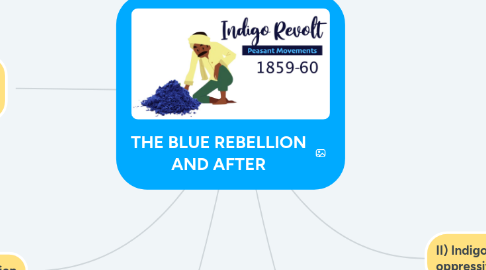
1. III) The news spread of a simmering revolt in the indigo districts
1.1. British government was worried about the possibility of another popular rebellion.
1.2. the Lieutenant Governor toured the region in the winter of 1859
1.3. The ryots saw the tour as a sign of government sympathy for their plight
2. IV) Spread of rebellion
2.1. The magistrate Ashley Eden issued a notice stating that ryots would not be compelled to accept indigo contracts, word went around that Queen Victoria had declared that indigo need not be sown
2.1.1. Eden was trying to placate the peasants and control an explosive situation, but his action was read as support for the rebellion.
2.2. intellectuals from Calcutta rushed to the indigo districts
2.2.1. They wrote of the misery of the ryots, the tyranny of the planters, and the horrors of the indigo system
3. V) British governments take after the rebellion
3.1. brought in the military to protect the planters from assault, and set up the Indigo Commission to enquire into the system of indigo production
3.2. Indigo Commission
3.2.1. The Commission held the planters guilty, and criticised them for the coercive methods they used with indigo cultivators
3.2.2. . It declared that indigo production was not profitable for ryots.
3.2.3. asked the ryots to fulfil their existing contracts but also told them that they could refuse to produce indigo in future.
4. I) In March 1859 thousands of ryots in Bengal refused to grow indigo
4.1. ryots refused to pay rents to the planters
4.2. attacked indigo factories armed with swords and spears, bows and arrows
4.3. Women turned up to fight with pots, pans and kitchen implements
4.4. Those who worked for the planters were socially boycotted
4.5. the gomasthas – agents of planters – who came to collect rent were beaten up
4.6. Ryots swore they would no longer take advances to sow indigo nor be bullied by the planters’ lathiyals – the lathi-wielding strongmen maintained by the planters.
5. II) Indigo system was intensely oppressive
5.1. Ryots thought they had the support of the locals against planters
5.1.1. headmen who had been forced to sign indigo contracts, mobilised the indigo peasants and fought pitched battles with the lathiyals
5.1.2. even the zamindars went around villages urging the ryots to resist the planters
